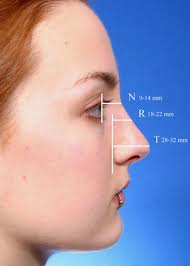Nuances of Profile Management- The Radix
Rhinoplasty: Achieving Natural Results
Introduction
As rhinoplasty has evolved from its reductive origins, the notion of nasal augmentation has become a fundamental principle within both primary and secondary procedures. Modern rhinoplasty surgeons have the skills to perform effective nasal augmentation, which may be combined with or used in lieu of reductive techniques. These surgical skills represent advancement in surgical techniques and have been aided by a philosophical shift in the approach to rhinoplasty. Utilizing these tools, a more balanced and natural appearing outcome may be achieved.

Figure 1- Measuring Nasal Height Nasal height is measured at the nasion (N), rhinion (R), and tip defining point (T) (pronasalae). The reference of origin for the nasion begins at the anterior corneal plane, while the vertical alar plane is referenced when measuring rhinion height and tip projection. Standard averages for each region are shown.
Profile refinement is one of the most common reasons patients seek consultation for rhinoplasty. Emphasis on creating a natural appearing nasal dorsum demands a methodical nasal and facial analysis. Areas of dorsal excess and deficiency are identified, quantitated and considered when determining surgical goals. The radix is an essential component of the profile, and carefully assessed from the standpoint of projection and position. Radix position profoundly impacts the appearance of the nasal profile by influencing dorsal length, contour, angulation, and height. When the radix is ideal in position and projection, rhinoplasty requires that the dorsal line be adjusted in relationship to the radix. This may require modification of the remaining dorsal line using reduction, augmentation or combination of these procedures. The goal of this modification is to create a straight profile or one with an appropriate supratip break depending on the patient’s desire. Theoretically, it may be preferable to establish an ideal projection of the nasal tip and radix and then modify the remaining dorsum. However, the senior author finds it is more practical to establish an ideal height of the bony and cartilagenous dorsum and then adjust tip and radix projection. To achieve ideal nasal tip projection, augmentation of the alar cartilages may be necessary using struts or grafts depending on the necessary degree of increased projection. In contrast, to reduce tip projection, the length of the alar cartilages may require shortening or a less invasive procedure may be adequate.
Similar to adjusting tip projection, the surgeon should also adjust the position and projection of the radix if it is not ideal. An over-projected radix is deepened using an osteotome or an electric powered drill system. In these situations, the bony dorsum is always over-projected, so for practical reasons the bony dorsum is lowered first or concomitantly with lowering of the radix. A caudally positioned radix is usually associated with an under-projected dorsum. In these circumstances, the entire dorsum is augmented using a bone or cartilage graft sufficient to provide proper height to the nasal bridge and position the nasofrontal angle cephalically. A deep under-projected radix is corrected with a radix graft. Similar to an over-projected radix,if the bony dorsum requires reduction it is preferable to reduce the dorsum before grafting the radix. Adjusting the nasal profile to a well-positioned radix will lead to a natural and attractive nasal profile.
Analysis of the Nasal Profile
The nasal profile consists of the osseocartilagenous dorsum, nasal tip, and their interface with the glabella and subnasale. The profile is defined by its contour, height, length, and interfacing angles. While used to describe the appearance of the profile as a whole, these individual characteristics also have a profound impact on each other.
The osseocartilagenous dorsum extends cephalad to the tip defining point ending at the nasion. The contour of the dorsal profile should be relatively straight and 1-2 mm below a line drawn from the nasion to the tip. This imparts the presence of a subtle break in the supratip region. Contour variations may exist based upon aesthetic taste, gender, ethnicity, and race. Generally, the ideal male nasal profile may be slightly convex at the rhinion, while a slight concavity is desirable in females.
The authors use the term dorsal height and dorsal projection interchangeably. The terms refer to the overall height of the dorsal nasal profile line from nasion to the tip defining point. Projection or height of the profile is assessed at the nasion, rhinion, and the tip defining point measured in the Frankfort horizontal plane (Fig. 1).
Page 1 | Page 2 | Page 3 | Page 4 | Page 5 | Page 6 | Page 7 | Page 8 | Page 9

